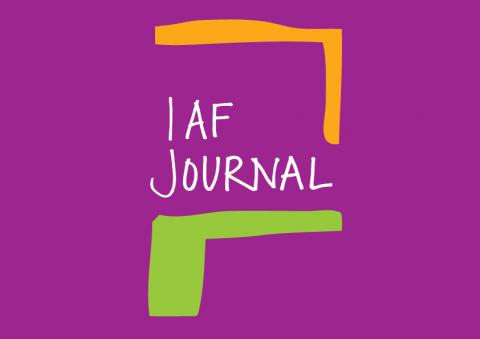Group Facilitation: Article Submission Guidelines
Aim and structure of the journal
Group Facilitation: A Research and Applications Journal is a multi-disciplinary publication focused on the art and science of group facilitation. The aim of Group Facilitation is to advance our knowledge of group facilitation and its implications for individuals, groups, organizations, and communities. The journal is comprised of the following sections, which are described below in more detail: Application and Practice; Theory and Research; Edge Thinking; Book Reviews.
Application and Practice is devoted to articles that reflect on facilitator experience. Articles appropriate for this section include reports on experiences gained and lessons learned presented in a reflective case study, and discussion of facilitator roles, problems encountered by facilitators or their clients, and intervention methods and techniques. Studies should be both descriptive and evaluative and should draw on existing literature appropriately.
Theory and Research is devoted to articles that explore, propose, or test practices, principles, or other aspects of facilitation models. Such studies are typically based on survey, experimental, ethnographic, or other research methods.
Edge Thinking is intended to stimulate thinking on new concepts and issues. Contributions may be less formal than the other sections, and might include dialogues, essays, editorials, and proposals for new areas of inquiry.
Book Reviews presents critical and comparative reviews of recent and classic books related to group facilitation. Guidelines for book reviews are available.
Publication ethics and publication practice
The Group Facilitation Journal is committed to upholding high standards of publication ethics and takes a number of measures against publication malpractices. All authors submitting their works to the Group Facilitation Journal for publication as original articles attest that the submitted works represent their authors’ contributions and have not been copied or plagiarized in whole or in part from other works.
If an earlier version of a submitted work has been published, the authors state clearly where it was published and how the new version of the submitted work differs. Authors also attest that their submitted work is not concurrently under review elsewhere. Authors acknowledge that they have disclosed all and any actual or potential conflicts of interest with their work or partial benefits associated with it.
In the same manner, the Group Facilitation Journal is committed to objective and fair double-blind peer-review of the submitted for publication works and to prevent any actual or potential conflict of interests between the editorial and review personnel and the reviewed material. Any departures from the above-defined rules should be reported directly to the Editor-in-Chief, who is committed to addressing any matters raised.
Article submission guidelines
Original manuscripts should be submitted via electronic mail to: Stephen Thorpe, Editor-in-Chief
The paper will be initiated into the review process when the following are received by the Editor in electronic form in either Microsoft Word, WordPerfect, or RTF format:
Page 1: Cover letter
- Title of the paper, authors' names, addresses, phone numbers, fax numbers, and e-mail
- A statement indicating, in 50 words or less, why this paper is appropriate for publication in Group Facilitation.
- Disclosure of any actual or potential conflicts of interest with the work or any partial benefits associated with it; and
A statement indicating that the paper
- has not been previously published (or if an earlier version was published, where it was published and how this version differs);
- is not concurrently under review elsewhere;
- conforms to the submission guidelines of Group Facilitation: A Research and Applications Journal.
Page 2: Title, acknowledgments, author biographies
Page 3: Title, abstract, keywords
Page 4: Title, start of complete paper
References: Complete references in the format specified in the APA Style Guide.
Appendices: Copies of any surveys, etc.
Final submissions must conform to these submission guidelines and include all items in the submission checklist.
Submission checklist
Accepted articles should be checked by the author to ensure that all of the submission requirements have been met. Following is a final submission checklist.
For articles
- Authors' names, addresses, phone numbers, fax numbers, and e-mail
- A 75-125 word narrative biographical sketch of each author
- Acknowledgments, if any
- An abstract
- List of keywords
- Complete references in the format specified in the Publication Manual of the American Psychological Association (APA Style Guide)
- Any surveys, data collection instruments, etc. in appendices
- Suggest two or more pull-out quotes (quotes from your paper that convey key ideas that will attract the readers attention).
- Permission to use any photographs, art work, or copyrighted material.
- Each figure and graphic in a separate file in TIFF, BMP, PICT, PNG, or PPT format (GIF and JPEG formats are NOT acceptable) and in hardcopy
For book reviews
For the book that is reviewed:
- Title, author(s), publisher, city state/ province/ country in which publisher is located, year of publication, total number of pages, ISDN number.
For the author of the review:
- Author's name, address, phone number, fax number, and e-mail.
- A 75-125 word narrative biographical sketch.
Writing an abstract
The abstract is a brief (150-250 word) overview -- an "executive summary" -- that states the nature, purpose, and benefits of your article or chapter.
It helps the reader decide whether or not to continue reading.
Your abstract should:
-
detail the subject of your article or chapter,
-
identify its primary audience (and any secondary audiences),
- indicate the approach your article or chapter takes to its subject — especially how that approach separates it from existing literature
- highlight the results, conclusions, and benefits it offers readers
- be written in narrative form
- not include an outline, bulleted lists, or lists of keywords
- not provide biographical information about the author
- not substitute for or repeat extensively information that should be in the introduction
For additional advice on writing abstracts, visit:
Information regarding APA Style
APA Publication Manual and Style Guides: http://www.apastyle.org
APA Style Tips: http://www.apastyle.org/learn/faqs/index.aspx
Purdue University Online Writing Lab – APA Style: https://owl.english.purdue.edu/owl/section/2/10
